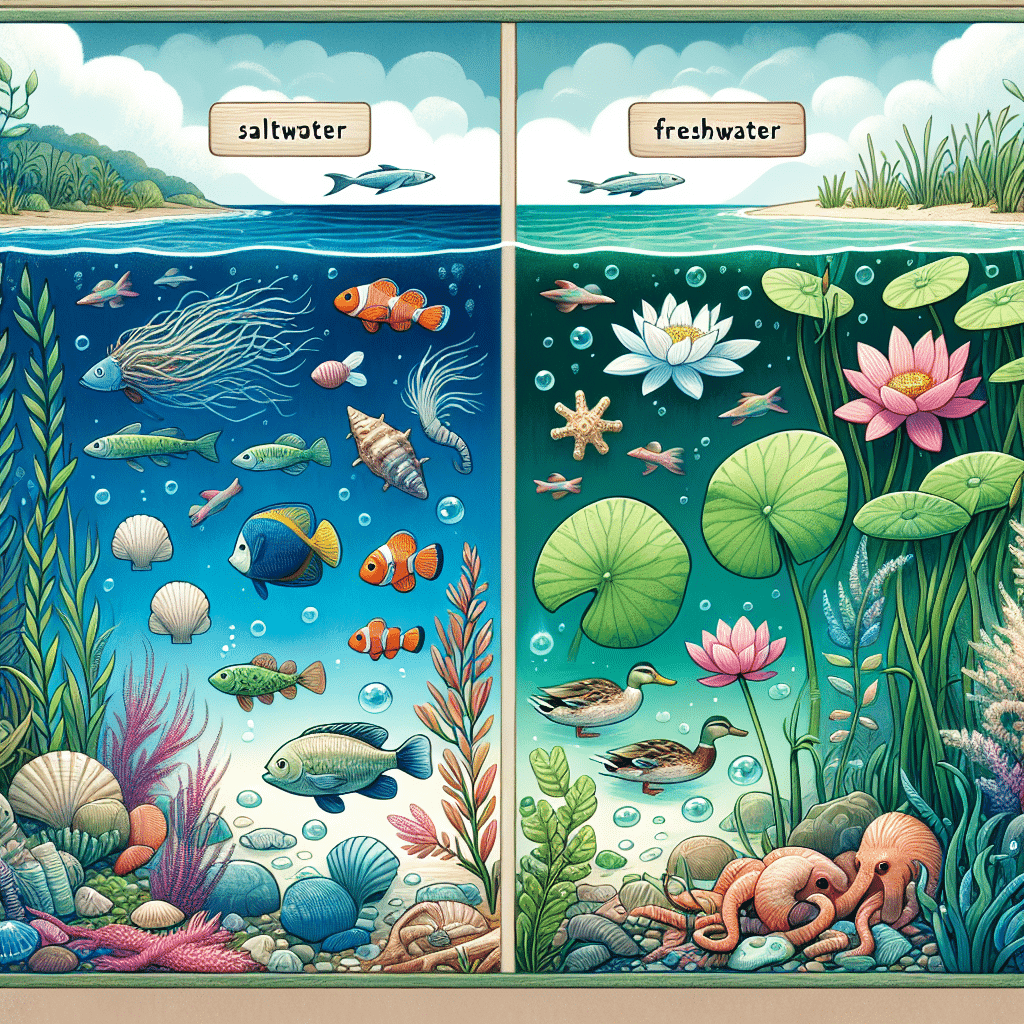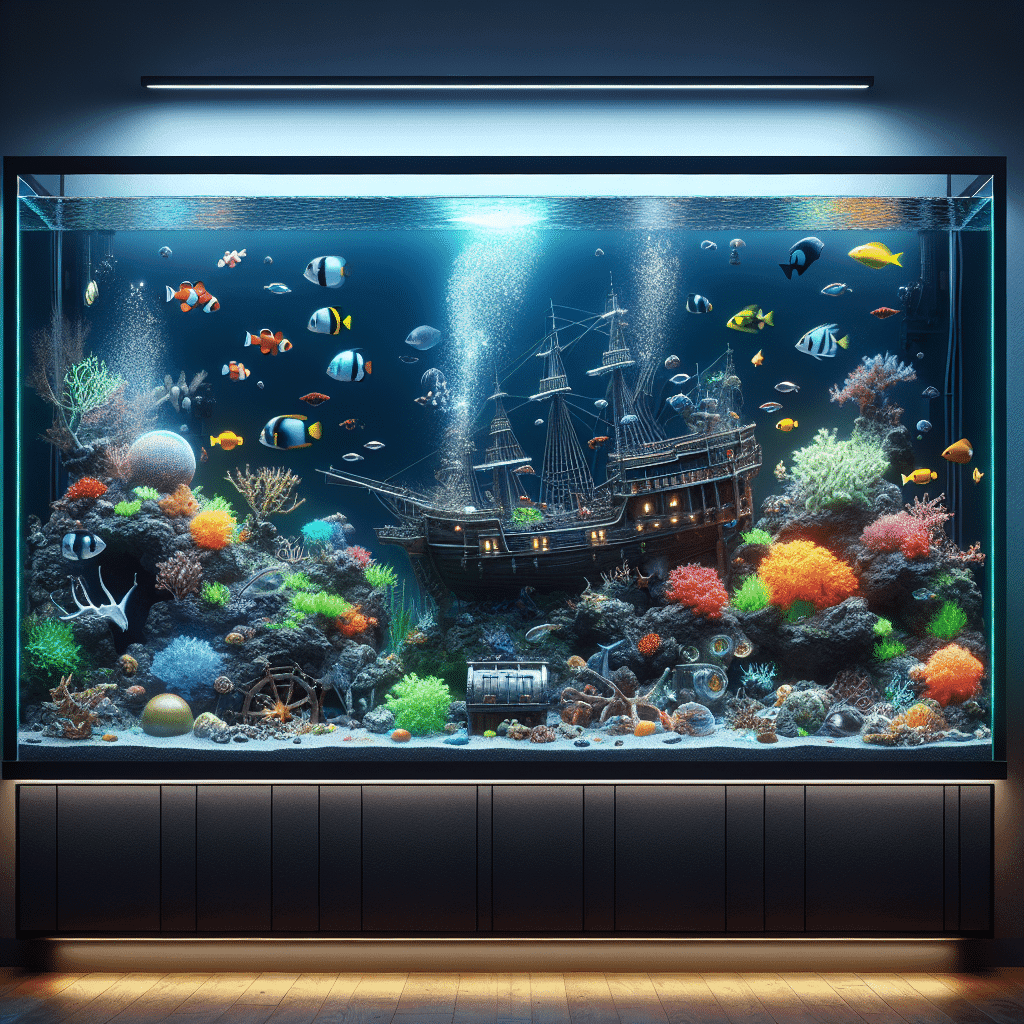Understanding Freshwater Ecosystems
Freshwater ecosystems are truly fascinating! I find it amazing to learn about the characteristics that define these environments and the diverse organisms that thrive within them.
Characteristics of Freshwater
Freshwater ecosystems are characterized by low salt content, typically less than 1%. This low salinity directly affects which organisms can survive here. For example, freshwater fish have specialized kidneys that help them excrete excess water, allowing them to thrive in these environments (Tutor Chase).
Freshwater ecosystems can be found in various forms, including wetlands, rivers, lakes, and aquifers. These ecosystems play a critical role in the global water cycle by supplying, purifying, and protecting freshwater resources.
| Freshwater Ecosystem Type | Description |
|---|---|
| Wetlands | Areas where water covers the soil, either permanently or seasonally, which supports a wide variety of plant and animal life. |
| Rivers | Flowing bodies of water that move from higher to lower ground, providing habitats for diverse species. |
| Lakes | Large, still bodies of freshwater that can support various ecosystems depending on their size and depth. |
| Aquifers | Underground layers of water-bearing rock that store freshwater. |
Organisms in Freshwater
The organisms found in freshwater ecosystems are fascinating! They include a wide variety of fish, invertebrates, plants, and microorganisms. Each of these organisms plays a unique role in maintaining the health of the ecosystem.
Some common freshwater fish include:
| Fish Species | Description |
|---|---|
| Goldfish | Popular aquarium fish known for their bright colors and adaptability. |
| Catfish | Bottom-dwelling fish that feed on detritus and are often found in rivers and lakes. |
| Trout | Freshwater fish known for their speed and agility, often found in cold, clear waters. |
| Bass | Predatory fish that thrive in lakes and rivers, popular among anglers. |
In addition to fish, freshwater ecosystems are home to various invertebrates, such as crayfish, snails, and insects, which contribute to the food web. Aquatic plants, like water lilies and cattails, provide habitat and shelter for these organisms while also producing oxygen through photosynthesis.
Understanding these characteristics and organisms gives me a deeper appreciation for the beauty and complexity of freshwater ecosystems. If you’re interested in setting up your own aquarium, check out our guide on saltwater aquarium setup for tips and insights!
Exploring Marine Ecosystems
As I dive into the fascinating world of marine ecosystems, I’m always amazed by how vital salinity is to the life that thrives in these waters.
Salinity in Marine Ecosystems
Marine ecosystems are characterized by a high salt content, typically around 3.5%. This salinity significantly influences the organisms that can survive in these environments. For instance, marine fish have specialized gills that help them excrete the excess salt they absorb from their surroundings (Tutor Chase).
To better understand how salinity impacts various marine life, here’s a quick overview:
| Organism Type | Adaptation to Salinity |
|---|---|
| Marine Fish | Specialized gills for salt excretion |
| Bivalves (e.g., Cockles) | Specialized siphon structures for filtering food |
| Coastal Plants | Firm attachment to rocks to withstand waves |
Adaptations of Marine Organisms
The diversity of habitats and unique environmental conditions in the marine ecosystem lead to fascinating adaptations among marine organisms. These adaptations can be categorized into three main types: structural, physiological, and behavioral (Science Learn).
Structural Adaptations: Many marine organisms have developed physical features that help them survive. For example, bivalves like cockles possess strong shells to protect against wave action, drying out, and predators.
Physiological Adaptations: Marine organisms have also evolved internal processes to cope with their salty environment. For instance, fish not only excrete excess salt but also regulate their internal salt concentration to maintain homeostasis.
Behavioral Adaptations: Some species exhibit behaviors that enhance their survival. Coastal plants like seaweed attach firmly to rocks to avoid being swept away by waves, while also developing tough, leathery fronds to withstand wave damage and sun exposure.
Understanding these adaptations is crucial for anyone considering a saltwater aquarium setup. It’s important to select species that are well-suited to the conditions you can provide. By paying attention to salinity levels and the unique needs of marine life, I can create a thriving ecosystem that mirrors the wonders of the ocean.
For more tips on maintaining your marine aquarium, don’t forget to check out resources on water changes, ph management, and equipment placement. Happy aquascaping!
Impact of Climate Change on Water
Ocean Salinity Changes
I find it fascinating how climate change is altering ocean salinity levels. These changes are not just numbers; they have real impacts on marine and coastal ecosystems. Human activities are contributing to fluctuations in salinity, which can affect ocean currents and stratification, disrupting the balance of marine life. For instance, a shift in salinity can influence oxygen saturation in the water, potentially leading to habitat loss and a decline in biodiversity (PubMed).
Here’s a quick overview of how ocean salinity changes can affect marine conditions:
| Impact Area | Effect of Salinity Changes |
|---|---|
| Ocean Currents | Disruptions can alter weather patterns |
| Oxygen Levels | Lower levels can lead to dead zones |
| Biodiversity | Loss of species and shifts in community structure |
Understanding these changes is crucial for anyone considering a saltwater aquarium setup, as they can directly impact the health of marine organisms.
Effects on Coastal Areas
Coastal areas are facing significant challenges due to climate change, especially with rising sea levels. Saltwater is intruding further inland, threatening drinking water supplies in places like Los Angeles and Bangladesh (Climate MIT). This is a critical issue for fish tank and reef tank hobbyists, as the quality of the water we use can be affected by these shifts.
The table below highlights some of the key effects of rising sea levels on coastal regions:
| Coastal Impact | Description |
|---|---|
| Saltwater Intrusion | Contaminates freshwater supplies |
| Increased Flooding | Higher risks during storms |
| Habitat Loss | Displacement of coastal species |
Additionally, warmer waters create ideal breeding grounds for harmful bacteria and viruses, which can lead to an increase in water-related diseases (Climate MIT). This is something I always keep in mind when managing water quality in my own aquariums. Learning about water safety and aquarium maintenance becomes even more important in the face of these changes.
For those of us passionate about marine ecosystems, it’s essential to stay informed about how climate change affects our underwater friends. Monitoring salinity levels and understanding the implications of water changes can help ensure a thriving environment for our aquatic life.
The Importance of Freshwater Ecosystems
Freshwater ecosystems play a vital role in our environment and are essential for many aspects of life. As someone who’s passionate about aquariums, I find it exciting to explore how these ecosystems contribute to the larger water cycle and help mitigate natural disasters.
Role in the Water Cycle
Freshwater ecosystems, including wetlands, rivers, and lakes, are critical components of the global water cycle. They supply, purify, and protect our precious freshwater resources (UN Water). Freshwater accounts for only about 3% of the water on Earth, while the remaining 97% is saltwater (RE Sources).
Here’s a quick breakdown of the different sources of freshwater:
| Freshwater Source | Percentage of Total Freshwater |
|---|---|
| Groundwater | 30.1% |
| Surface Water (Lakes, Rivers) | 69.3% |
| Frozen Water (Glaciers, Ice Caps) | 0.6% |
Freshwater ecosystems are responsible for filtering and replenishing this limited resource, acting as natural purifiers that keep our water clean and safe to use.
Mitigation of Natural Disasters
Another fascinating aspect of freshwater ecosystems is their ability to mitigate the impacts of floods and droughts. They help regulate water flows, acting as storage buffers during dry spells and protecting the land from erosion and inundation. Wetlands, for example, can absorb excess rainwater, which reduces flooding in surrounding areas.
In addition to their flood control capabilities, freshwater ecosystems can also serve as a natural alternative to conventional water treatment systems. They filter and purify wastewater before it enters rivers or lakes, contributing significantly to overall water quality (UN Water).
Understanding the importance of these ecosystems not only enhances my appreciation for aquariums but also highlights the need to protect and maintain them. As I delve into my own saltwater aquarium setup, I realize that the health of our freshwater systems impacts everything from water changes to overall tank maintenance.
Challenges in Water Quality
As I dive into the world of aquariums, understanding water quality becomes crucial for my success with both saltwater and freshwater setups. Two major challenges I face are turbidity in lake water and the complexities of wastewater treatment.
Turbidity in Lake Water
Turbidity refers to the cloudiness or haziness of water caused by suspended particles. In lakes, high turbidity is a growing concern. These suspended particles can act as magnets for pollutants and bacteria, negatively affecting human health and the ecosystem. This issue can also damage tourism, as clear water is often more attractive to visitors.
| Turbidity Level (NTU) | Water Quality | Impact |
|---|---|---|
| 0 – 5 | Clear | Ideal for aquatic life |
| 5 – 25 | Slightly Cloudy | Possible impact on photosynthesis |
| 25 – 100 | Cloudy | Harmful to fish and aquatic plants |
| > 100 | Very Cloudy | Severe ecosystem disruption |
When setting up my aquarium, maintaining low turbidity is essential for the health of my fish and corals. Regular monitoring and implementing filtration systems help keep the water clear and healthy.
Wastewater Treatment
Another important aspect of water quality is wastewater treatment. As a hobbyist, I need to be aware of how wastewater impacts my local water sources. Wetlands can serve as effective alternatives or supplements to traditional wastewater treatment systems. They filter and purify wastewater before it enters rivers or lakes, helping maintain a cleaner ecosystem (UN Water).
For my aquarium, understanding the processes involved in wastewater treatment can help me appreciate the importance of maintaining clean water in both my tank and the surrounding environment. It’s vital to ensure my setup contributes positively to water quality by using proper filtration and performing regular maintenance.
Remember, good water quality is key to thriving aquatic life. For more tips on maintaining water quality in my aquarium, I can check out articles on water changes, water safety, and aquarium maintenance.
Global Water Distribution
Understanding the distribution of water on our planet is key when deciding between a saltwater or freshwater aquarium. I find it fascinating how the majority of Earth’s water is saltwater, with significant implications for aquarium hobbyists.
Saltwater vs. Freshwater
Did you know that approximately 97% of the water on Earth is saltwater? That leaves just 3% as freshwater, which is essential for life and aquarium setups! Here’s a quick look at the breakdown:
| Water Type | Percentage of Total Water |
|---|---|
| Saltwater | 97% |
| Freshwater | 3% |
This stark contrast highlights the dominance of saltwater in our oceans, making it crucial for reef tank enthusiasts like me to appreciate just how rare freshwater is.
Availability of Freshwater
Of that 3% of freshwater, it’s even more surprising to learn that about 69% is trapped in glaciers and ice caps. Additionally, around 30% is found deep underground, which means that only a tiny fraction is readily available for our use. In fact, less than 1% of all freshwater is on the surface in lakes, streams, and rivers, and a significant portion of that is often polluted or unsafe for consumption.
| Freshwater Distribution | Percentage of Freshwater |
|---|---|
| Glaciers and Ice Caps | 69% |
| Groundwater | 30% |
| Surface Water (Lakes, Rivers) | <1% |
This limited availability of surface freshwater emphasizes the importance of proper water changes and water safety in maintaining a healthy aquarium environment.
For hobbyists like me, understanding these percentages helps to highlight why choosing between a saltwater or freshwater setup can impact not only the type of fish but also the overall ecosystem we are creating in our tanks. If you’re diving into the realm of saltwater aquariums, exploring topics like saltwater aquarium setup and saltwater mixing measuring will be essential!
Desalination Process
Turning Saltwater into Freshwater
Desalination is the exciting process of transforming saltwater into freshwater, making it a hot topic for many aquarium enthusiasts like me. This method is essential for those of us who want to maintain a saltwater aquarium setup but may not have direct access to ocean water. The process typically involves two main techniques: reverse osmosis and distillation.
- Reverse Osmosis: This method forces saltwater through a semi-permeable membrane, which allows only freshwater molecules to pass through while blocking out the salt and other impurities.
- Distillation: This method involves boiling saltwater and then collecting the steam, which leaves the salt behind. Once cooled, the steam condenses into freshwater.
Both methods require a considerable amount of energy and resources, making desalination quite expensive.
| Desalination Method | Description | Energy Requirement |
|---|---|---|
| Reverse Osmosis | Forcing water through a membrane | High |
| Distillation | Boiling water and collecting steam | Very High |
Environmental Impacts
While the process of converting saltwater to freshwater is fascinating, it also comes with some environmental challenges. Desalination plants can negatively affect marine ecosystems by sucking in small ocean creatures such as baby fish and plankton. This disrupts the food chain, which is crucial for sustaining ocean life (RE Sources).
Additionally, the waste produced from the desalination process, primarily salt, is often pumped back into the ocean. This can significantly increase local salinity levels, which may harm aquatic life. As a marine tank hobbyist, I always keep these factors in mind when considering the sustainability of my aquarium practices.
For maintaining a healthy aquarium environment, ensuring water safety and understanding aquarium maintenance are key. Whether planning for water changes or managing light management, the impact of my choices can extend beyond my tank.
Sustainability of Water Resources
When I think about maintaining a thriving aquarium, the sustainability of water resources is a crucial topic. It’s fascinating to explore how our choices impact the environment, especially when considering the processes involved in making saltwater usable for our tanks.
Energy Consumption in Desalination
Desalination is an exciting process that turns saltwater into freshwater. However, it requires a significant amount of energy and resources, making it quite expensive (RE Sources). For those of us who love our marine tanks, it’s essential to understand the implications of using desalinated water.
| Desalination Process | Energy Required (kWh/m³) |
|---|---|
| Reverse Osmosis | 3-7 |
| Multi-Stage Flash Distillation | 10-15 |
| Multi-Effect Distillation | 6-12 |
The energy consumed in desalination is substantial, and this raises questions about sustainability. As aquarium hobbyists, we should consider not only the costs associated with desalination but also the environmental impact it has.
Harm to Marine Life
While the process of desalination is beneficial for creating freshwater, it can also have detrimental effects on marine ecosystems. Desalination plants often suck in small ocean creatures, such as baby fish and plankton, disrupting the food chain. This can lead to imbalances in local aquatic life, affecting biodiversity.
Additionally, when the salt that is separated from the water is pumped back into the ocean, it can create high-salinity zones that harm nearby organisms. As a responsible aquarium enthusiast, I feel it’s vital to support practices that minimize these negative impacts.
For those of us setting up a saltwater aquarium, it’s essential to be aware of how our choices influence the environment. By prioritizing sustainable practices, we can enjoy our beautiful reef tanks while protecting the natural ecosystems we cherish.



